MOSCOW (pop 11.8 million)
The St Petersburg train arrives in Moscow at Leningradsky vokzal Train Station next to the Komsomolskaya Metro. I arrived at 6PM at the height of rush hour. The pace was frenetic – people were almost running and crowds huge. I went to tourist information tucked away in a far corner of the station. It looked like I was the first person they had seen all day. The unsmiling clerk gave me an English version of the Moscow Metro system which can be very helpful. I needed to find the ring line and it seemed like a mile of connecting passageways. The Moscow Metro is initially a difficult subway system to navigate. There are no color-coded arrows or overhead signs like in most systems – instead they are on the floor. Russians are generally not helpful with their poor English – although some are very nice. The most difficult part is choosing between the two directions available at each station as this bit is only in Cyrillic. Refer to the separate section on the Russian Metro at the end of this section.
I stayed at Godzillas Hostel, the top rated hostel in Moscow. It is a purpose-built hostel with all the facilities.
RED SQUARE. This 400m-by-150m area of cobbles is at the heart of Moscow. The square forms the eastern side of the Kremlin. Once a merchant area, then the site for military parades and now the location for concerts, festivals and cultural events, it is surrounded by many iconic Russian sites. Try to go at night to see all the lights of the GUM store, St Basils and the Kremlin.
St. Basil’s Cathedral. Built from 1555-61 by Ivan the Terrible, it is a crazy confusion of coloured onion domes and shapes. Inside there are 9 chapels, the tall, tent shaped one in the centre surrounded by 8 small chapels. There are lovely frescoed walls and tons of nooks and crannies to explore.

Lenin Mausoleum. On the west side next to the Kremlin, in a large granite tomb, is the embalmed body of Vladimir Lenin. Everyone troops solemnly past the oddly waxy figure. The embalming formulae is a closely guarded secret but my bet is that he is indeed wax. His brain was removed, and sliced and diced for the next 40 years in the hope of uncovering its hidden genius.
Kitai-Gorod GUM. GUM (State Department Store) is the main department store in many cities of the former Soviet Union. The most famous GUM is the large store facing Red Square in the Kitai-gorod area – traditionally a centre of trade in Moscow.
It once symbolized all that was bad about Soviet shopping: long queues and empty shelves. Behind the elaborate 19th century façade, is a gorgeous three- storied shopping centre. The 1000 shops contain all the most exclusive world brands. Who buys all this expensive stuff? At night all windows and the roofline are lit up. The large specialty grocery store is a treat to explore as it has exotic food from all over the world – who could afford to shop there?
The façade extends for 794 ft (242 m) along the eastern side of Red Square built 1890-93. It has a steel framework and glass roof, a similar style to the great 19th-century railway stations of London. The glass-roofed design (diameter 46 ft or 14 m)made the building unique at the time of construction. It looks light, but it is made of 743 tons, capable of supporting snowfall accumulation. Illumination is provided by huge arched skylights of iron and glass, each weighing some 740 tons and containing in excess of 20,000 panes of glass. The facade is divided into several horizontal tiers, lined with red Finnish granite, Tarusa marble, and limestone. Each arcade is on three levels, linked by walkways of reinforced concrete. As a private shopping mall, it was renamed in such a fashion that it could maintain its old abbreviation and thus still be called GUM. However, the first word Gosudarstvennyi (‘state’) has been replaced with Glavnyi (‘main’), so that GUM is now an abbreviation for “Main Universal Store”.

State History Museum. Occupying the north end of the square, the building itself is an attraction, with each room in the style of a different region or period.
KREMLIN (a ‘kremlin’ is a town’s fortified stronghold). Shaped like a large triangle, behind its crenellated red brick walls with 19 distinctive towers rise many typical Russian buildings. The entrance is on the west side past the Tomb of the Unknown Soldier (the remains of a soldier who died in December, 1941 at km41, the nearest the Nazis came to Moscow). The dramatic high-stepping changing of the guards happens every hour. Next to the Kremlin on this side is the lovely Alexander Park with some spectacular fountains and another big shopping centre full of brand name stores.
The 350R general admission gets you into four churches but that is it. Ivan the Great Bell Tower and the Armory require separate admissions. Don’t renege on the Armory (700R) with its fantastic display of precious silver and gold metal works, jewelry, armor, weapons, gowns, and carriages. The most intriguing are the collection of Faberge eggs – most were gifts exchanged between Nicholas II and his wife each year at Easter. Most famous is the Grand Siberian Railway egg with its gold train and platinum locomotive. Inside the Armory is also the Diamond Fund Exhibition (another 500R) with its lavish collection of precious stones (30,000 carats of rough diamonds, and 5 uncut diamonds of 241, 232, 298, 320 and 342 carats), jewelry and huge gold and platinum nuggets. Unfortunately the guide listed all the contents of each showcase but there are no individual labels. There are only 2 other collections of equal status – the crown treasure of England and the treasure of the previous Shah of Iran.
Also on the grounds are the Tsar Cannon (weighs 40 tons, balls too big to fire) and the Tsar Bell (at 200 tons, 6.14m tall and 6.6m in diameter, the largest bell in the world, water was accidentally splashed on it when cooling and a huge chunk broke off rendering the bell useless).
KOLOMENSKOYE
Church of the Ascension, Kolomenskoye. Kolomenskoye was a favourite country estate of grand princes of Muscovy 7kms SE of the city centre. The 390 hectare scenic area overlooks the steep banks of the Moskva River. It became a part of Moscow in the 1960s.

The earliest existing structure is the exceptional Ascension church (1532), built in white stone to commemorate the long-awaited birth of an heir to the throne, the future Ivan the Terrible. Being the first stone church of tent-like variety, the uncanonical “White Column” (as it is sometimes referred to) marked a stunning break from the Byzantine tradition.
The church has a cross-shaped ground floor, followed by octagonal body, and then an octagonal tent, crowned by a tiny dome. The narrow pilasters, the arrow-shaped window frames, the three tiers of the kokoshniks and the quiet rhythm of stair arcades and open galleries underline the dynamic tendency of this masterpiece of the Russian architecture. World Heritage List 1994.
Kolomenskoye palace. Tsar Alexis I had all the previous wooden structures in Kolomenskoye demolished and replaced them with a new great wooden palace, famed for its fanciful, fairytale roofs. Foreigners referred to this huge maze of intricate corridors and 250 rooms, as ‘an Eighth Wonder of the World’. Although basically only a summer palace, it was the favourite residence of Tsar Alexis I. Upon the departure of the court for St. Petersburg, the palace fell into disrepair. On her orders the wooden palace was demolished in 1768, and replaced with a much more modest stone-and-brick structure.
Detailed plans of the Alexis I palace survived and a full-scale reconstruction was completed in 2010, 1km from its original location near the White Column, in order to preserve the historic foundations.
ENSEMBLE of the NOVODEVICHY CONVENT (Bogoroditse-Smolensky Monastery) is probably the best-known cloister of Moscow. Unlike other Moscow cloisters, it has remained virtually intact since the 17th century.
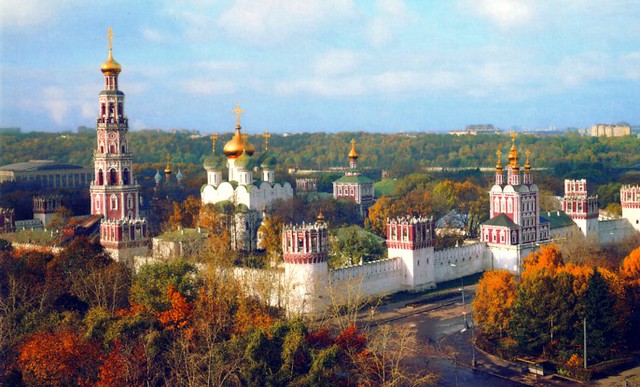
In 2004, it was proclaimed a UNESCO World Heritage Site. In SW historic Moscow, it has a high masonry wall with 12 towers and surrounded by a park, with the Moscow River on the west side.
Smolensky Cathedral 1524-5) – the oldest structure is the six-pillared five-domed dedicated to the icon Our Lady of Smolensk. Its frescos are among the finest in Moscow.
The blood-red walls and crown-towers, two lofty over-the-gates churches, a refectory, and residential quarters were all designed in the Muscovite Baroque style. The belltower is 72 metres (236 ft), making it the tallest structure in 18th-century Moscow. The convent is the most outstanding example of the so-called “Moscow Baroque”.
Necropolis of the Novodevichy Convent dates from the 16th century and was coveted by the Russian nobility as a place of burial.In 1898–1904, the Novodevichy Cemetery was established outside the south wall. Anton Chekhov was one of the first notables to be interred at the new cemetery. During the Soviet epoch, it was turned into the most high-profile cemetery in the Soviet Union, with Peter Kropotkin, Nikita Khrushchev, Sergei Prokofiev, Dmitri Shostakovich, Konstantin Stanislavski, Boris Yeltsin, and Mstislav Rostropovich.

Lubyanka is the popular name for the headquarters of the FSB and affiliated prison on on Lubyanka Square. It is a large Neo-Baroque building with a facade of yellow brick. It was previously the national headquarters of the KGB; Soviet hammers and sickles can still be seen on the building’s facade. A prison at the ground floor of the building figures prominently in Aleksandr Solzhenitsyn’s classic study of the Soviet police state, The Gulag Archipelago. After the dissolution of the KGB in 1991, Lubyanka became the headquarters of the Border Guard Service of Russia, houses the Lubyanka prison, and a museum of the KGB
Worker and Kolkhoz Woman is a sculpture of two figures with a sickle and a hammer raised over their heads. It is 24.5 meters (78 feet) high, made from stainless steel by Vera Mukhina for the 1937 World’s Fair in Paris, and subsequently moved to Moscow outside the All-Russia Exhibition Centre.
The sculpture is an example of both socialist realistic and Art Deco styles. The worker holds aloft a hammer and the kolkhoz woman a sickle to form the hammer and sickle symbol.
Monument to Yuri Gagarin is a 42.5-meter high pedestal and statue of Yuri Gagarin, the first person to travel in space. It is located at Leninsky Prospekt. The pedestal is designed to be reminiscent of a rocket exhaust. The statue is made of titanium, a metal often used in spacecraft, and weighs 12 tons.

Tsytsin Main Moscow Botanical Garden of Academy of Sciences was founded in April 1945, and claims to be the largest botanical garden in Europe with an area of 3.61 km², bordering the VDNKH Exhibition Center, and contains a live exhibition of more than twenty thousand different species of plants coming from various parts of the world. The rosarium has 20,000 rose bushes, a dendrarium (arboretum), an oak forest with the average age of the trees exceeding 100 years, a Japanese garden and a greenhouse of more than 5000 square meters.
Laika Monument. The Russian mutt known as Laika is the first animal to completely orbit the Earth from space (although to be fair she was dead for the vast majority of the journey), and after more than 50 years, a monument to the brave dog was finally installed near a Moscow military facility in 2008. The (surprisingly small) monument is shaped like an abstract rocket that morphs into a hand, cradling Laika towards the stars.
Tretyakov Gallery is on the south side of the Moscow River. Moscow’s most famous gallery, it holds an outstanding collection of pre-revolutionary Russian art and the world’s best collection of Russian icons. From the gallery, I walked along the river.
Peter the Great Statue is a 98-metre-high (322 ft) monument to Peter the Great, located at the western confluence of the Moskva River and the Vodootvodny Canal in central Moscow. At 94.5m, it is twice as tall as the Statue of Liberty without its pedestal). It was built to commemorate 300 years of the Russian Navy, which Peter the Great established. It was erected in 1997 and is the eighth-tallest statue in the world. It weighs around 1,000 tons and contains 600 tons of stainless steel, bronze and copper.
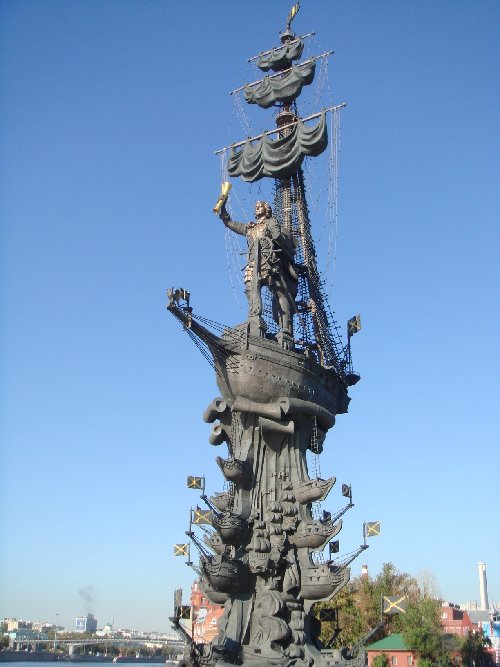
The 3km long Gorky Park hugs the river. Russians do flower beds like no one else. The several ponds are used for ice skating in the winter. Cruise boats ply the river.
Pushkinsky Pedestrian Bridge (2000). Instead of scrapping the steel arch of the 1907 Andreyevsky Rail Bridge, city planners re-used it as a structural core for the new pedestrian bridge. Concrete foundations, pillars and arches were finished with granite slabs salvaged from the old site. Moskva river at this point is wider than at St.Andrew’s, so four pillars and three 25-meter arches over water were required to close the gaps.
Pushkinsky bridge connects First Frunzenskaya street in Khamovniki (left bank) with the southern edge of Gorky Park and Titovsky Proezd leading to Leninsky Avenue (right bank). Main pedestrian walkway and stairs are completely enclosed in a glass canopy; there are two open-air side walkways. Left bank entrance has a two-lane escalator. On the right bank, the main flat walkway extends 240 metres past the pillars through the park.
Arbat is a pedestrian street about 1km long in the historical centre present since the 15th century and forms the heart of the Arbat District of Moscow. Originally the street formed part of an important trade-route and was home to a large number of craftsmen. In the 18th century, the Russian nobility came to regard the Arbat as the most prestigious living area in Moscow. Almost completely destroyed by the great fire of 1812 associated with Napoleon’s occupation of Moscow, the street required rebuilding. In the 19th and early 20th centuries it became known as the a place where petty nobility, artists, and academics lived. In the Soviet period, it housed many high-ranking government officials. As of 2016, the street and its surroundings are undergoing gentrification, and it is considered a desirable place to live. Because of the many historic buildings, and due to the numerous artists who have lived and worked in the street, the Arbat has also become an important tourist attraction.
Bolshoi Theatre. The main building, rebuilt and renovated several times during its history, is a landmark of Moscow and Russia (its iconic neoclassical façade is depicted on the Russian 100-ruble banknote). In 2011, the Bolshoi re-opened after an extensive six-year renovation costing 21 billion rubles ($688 million). but it is claimed much more public money was spent.
Pushkin cafe. (Café Pouchkine) is a famous coffee, tea room, pastry, brasserie and gourmet restaurant in a Baroque 17th century mansion. It was founded in 1999 on the bicentenary of the birth of the famous Russian poet novelist Alexander Pushkin (1799-1837).
MOSCOW’S METRO STATIONS – Underground Art
Initially this appears to be the most difficult metro in the world to navigate. Here the directions to connecting stations are usually on the floor (and this is a recent addition to the system). The real challenge is the directions at each individual station (which side to be on for your destination) are all in Cyrillic. On the wall opposite where you stand to board, the stations for your particular line are on the top row in the color of the line and under each are listed the stations of the line that that station connects to. It takes a while to understand. The trains are reliable and you rarely wait longer than 3 minutes. The escalators in Moscow’s Metro stations must be the longest in the world. I timed how long the ride was – 123 seconds. They are this deep so that they could function as bomb shelters in time of war.
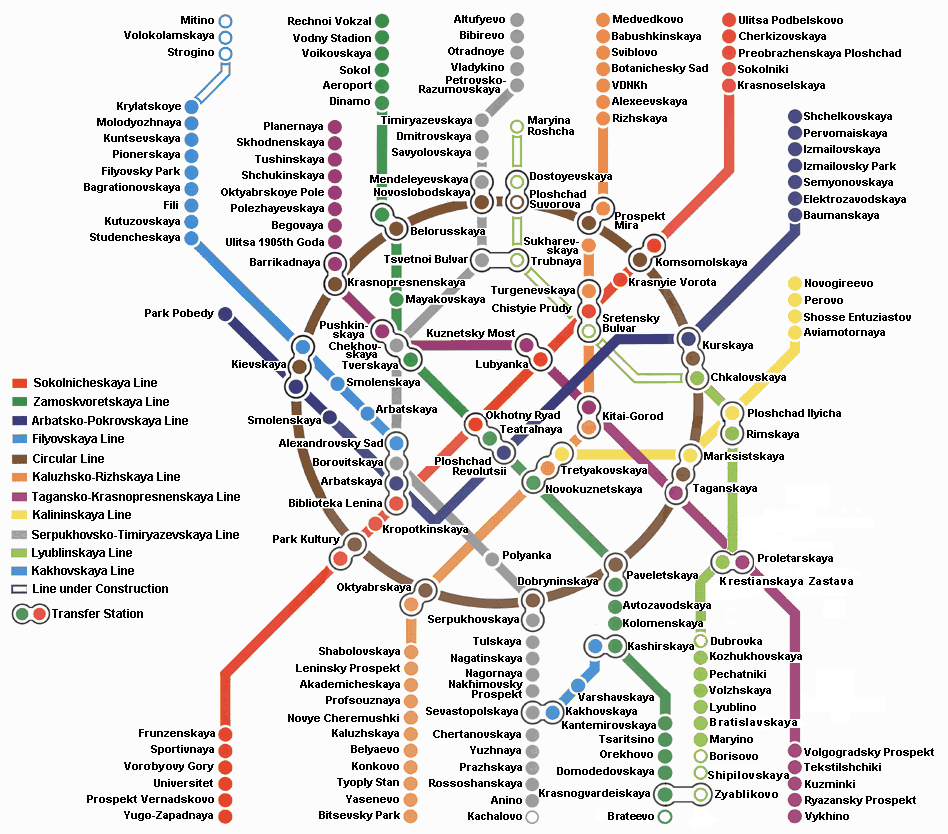
Moscow’s Metro stations are spectacular creations of art. All 150+ of them are nice with a profusion of marble in the stations and passages connecting stations. Google “Moscow’s Best Metro Stations” and there are several lists. It is easy to see the 15 or so best ones in about 3 hours. This will be your cheapest 3 hours in Moscow – you can see them all for one $1 (40R) fare. I also gained some understanding of Cyrillic which is radically different from our alphabet.
Most of the good stations are on two lines – the ring Kolsevaya or brown line (arguably the most opulent in a system known for its palatial stations) and the Arbatsko-Pokrovskaya or dark blue line – only three on my list were off these lines. Start your trip at 9PM or so when the system is not busy. I stayed at Godzillas Hostel in the north central area of Moscow and started my evening at the closest Metro – Tsetvoy Bulvar on the grey line.
From Tsetvoy Bulvar go NW to Novosloboskaya (Koltsevaya or brown line).
1. Novoslobodskaya. It is best known for its 32 stained glass panels. Each panel, surrounded by an elaborate brass border, is set into one of the station’s pylons and illuminated from within. Both the pylons and the pointed arches between them are faced with pinkish Ural marble and edged with brass molding. At the end of the platform is a mosaic by Pavel Korin entitled “Peace Throughout the World.” The vestibule is an imposing structure with a grand portico, located on the northeast corner of Novoslobodskaya Ulitsa and Seleznevskaya Ulitsa.
Continue on brown line to:
2. Belorusskaya. It is named for the nearby Belarus rail terminal. It opened in 1952, serving briefly as the terminus of the line before the circle was completed in 1954. The station has low, white marble pylons, an elaborately patterned plaster ceiling, light fixtures supported by ornate scroll-shaped brackets, and a variety of decorations based on Belarusian themes. Overhead, twelve octagonal mosaics depict Belarusian daily life, and underfoot the platform is intricately tiled to resemble a Belarusian quilt. A sculptural group called “Soviet Belorussia” used to stand at the end of the platform before it was removed in 1998 to make room for a second entrance. Another sculptural group, “Belarusian Partisans,” is located in the passage between this station and Belorusskaya-Radialnaya.

Change to the dark green line for a short detour to the gem of the system:
3. Mayaskovskaya. This is a monument to pre-WWII Stalinist Architecture. There are stainless steel and pink rhodonite columns with grey marble walls. The floor is marble in geometric patterns. The highlight is 34 inset ceiling mosaics showing an idealized Soviet future. Most have airplanes, but some show sports and flowers. This station was the Grand Prize winner at the 1938 World’s Fair in New York.

Return back to the brown line and continue on to:
4. Krasnopresnenskaya. It was opened in 1954. The station has red granite pylons with white marble cornices and 14 bas-reliefs. Eight of the bas-reliefs depict the events of the Russian Revolution of 1905 and the other six show scenes from the Russian Revolution of 1917. Statues of Lenin and Stalin originally stood at the end of the platform, though these had been removed by the early 1960s.
Continue on the brown line to:
5. Kievskaya. It is named for the nearby Kievsky Rail Terminal. The design for the station was chosen in an open competition held in the Ukraine. Kievskaya features low, square pylons faced with white marble and surmounted by large mosaics, celebrating Russo-Ukrainian unity from 1654 to 1945. Both the mosaics and the arches between the pylons are edged with elaborate gold-coloured trim. At the end of the platform is a portrait of Lenin.
Change to the dark blue line and go west to:
6. Park Pobody. The columns are white and rust marble producing a very sleek, modern look. At the end is a large enamelled ceramic celebrating the end of WW II in 1945.
Return back continuing on the dark blue line passing Smolenskaya to:
7. Arbatskaya. Along with Smolenskaya and Kievskaya, it was built in 1953 to replace an older, parallel section of track that has since become part of the Filyovskaya Line. The old station had been damaged in a German bomb attack in 1941, so its replacement was much deeper and included larger stations that could double as shelters. Although it was initially supposed to be closed permanently, the old section was reopened five years later.
Continue on the dark blue line to:
8. Ploshchad Revolyutsii. 76 life-size bronze statues of soldiers, farmers, children and workers are on the dark marble columns. It is good luck to rub the nose of the dog, the chicken and the little boys penis so the dark brown patina is rubbed down to the golden bronze.
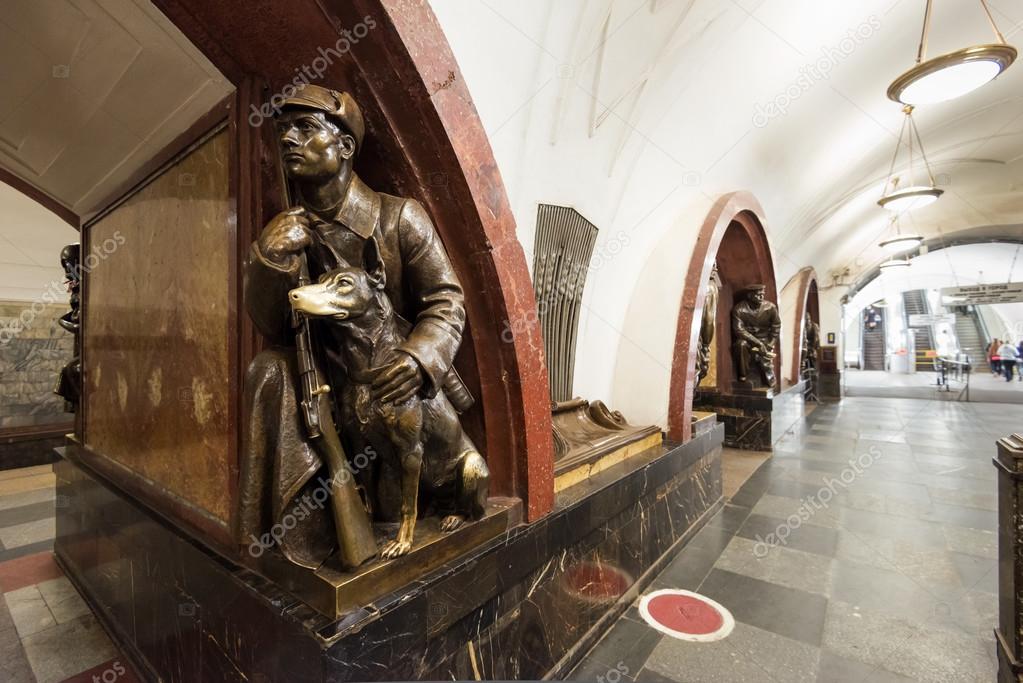
Bypass two stations staying on the dark blue line to:
9. Electrozavodskaya (Electric Factory). It is one of the more spectacular and better-known stations on the Moscow Metro opened in 1944. Aptly named for a nearby power plant, Elektrozavodskaya’s defining feature is the ceiling, which is almost completely covered by six rows of circular incandescent inset lamps – 318 in all.

In keeping with the electrical theme, the inside of the vestibule is decorated with portraits of pioneers in electricity and electrical engineering. The platform is relatively short, with only six white marble pylons on each side. The inward-facing sides of the pylons are decorated with bas-reliefs depicting the Soviet Union’s industrial and agricultural workers. The outside faces have sconces and decorative metal grilles depicting the hammer and sickle.
Return back on the dark blue line changing to the brown line at Kurskaya and continue to:
10. Taganskaya. It was opened on January 1, 1950. The station is decorated with fourteen large triangular majolica panels which include cameo portraits of heroes of the Red Army as well as intricate floral designs. The panels facing the centre of the station are coloured pale blue while those facing outwards are untinted. There was originally a marble bas-relief at the end of the platform depicting Stalin surrounded by an adoring throng, but this was torn out in 1966 when the passage to Taganskaya-Radialnaya was built. Another artwork in the station is a circular ceiling panel entitled “Victory Salute” located in the intermediate hall between the two sets of escalators.
Return back on the brown line bypassing Kurskaya to:
11. Komsomolskaya. It opened on January 30,1952.The station’s most noticeable feature is its grandiose Baroque-style ceiling, which is painted pale yellow and encrusted with large mosaics and floral moldings.
The ceiling is supported by 68 octagonal white marble columns with modified Ionic capitals. The artistic theme of the station is Russia’s fight for independence and historical struggles against invaders. In keeping with this theme are the eight large mosaics along the centre of the ceiling. At the end of the platform are a bust of Lenin and an arch decorated with gilt floral designs and the Soviet coat of arms. The station’s vestibule is built on a grand scale as well, with an immense octagonal dome, cupola, and spire and imposing full-height portico with stylized Corinthian columns. Most everyone will go through this station as it gives access to the trains to St Petersburg and the Trans-Siberian.
Continue on the brown line to Prospekt Mira and change to the orange line (Kaluzhsko-Rizhskaya line) to:
12. Prospekt Mira (Avenue of Peace). Opened on May 1, 1958, the station features flared pylons faced with white marble and trimmed with sharp-edged metal cornices. The walls are faced with off-white ceramic tile with horizontal black stripes.
Continue on the orange line heading south to Turgenevskaya where you change lines to the light green line at Stretensky Bulvar (stainless steel columns) heading north to:
13. Dostoevskaya. The light green line is a new line with this station opening in 2010. The marble murals are from scenes of Dostoyevsky’s books with a large portrait of the author at the end. One scene was controversial as it contains a murder scene.

Return on the light green line to:
14. Trubnaya. Another very modern station, it has glass mosaics surrounded by metal light supports in the green marble columns.
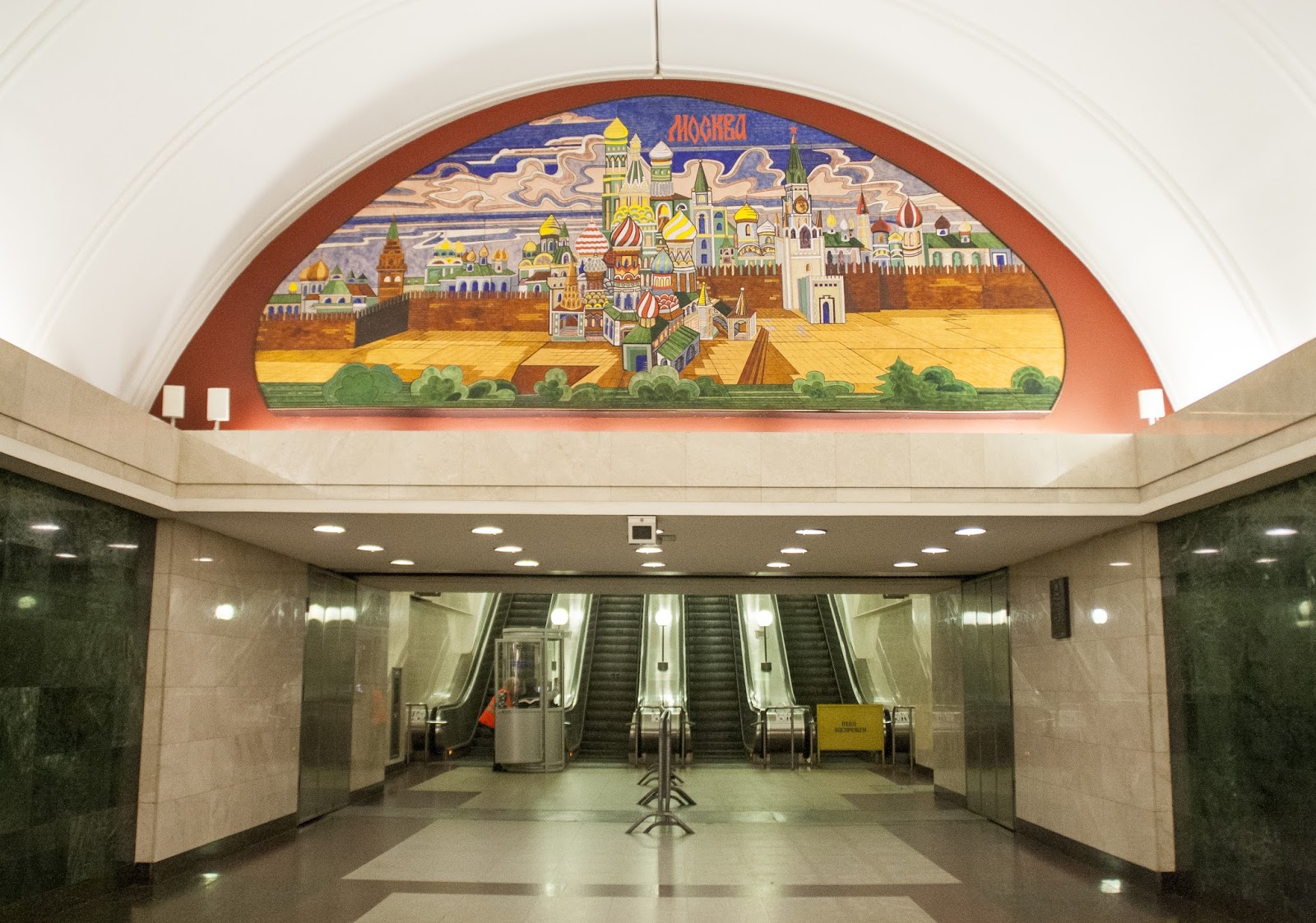
Trubnaya connects back to Tsvetnoy Bulvar and home! Have a good nights sleep.
Other stations that were apparently good but I did not see are: Partiznaskaya (decorated with AK-47 machine guns), Novokunznetskaya (military bas-reliefs, ceiling mosaics and elegant marble benches), Shossi Entuziastov, and Nakhimovsky Prospekt.
MODERN ARCHITECTURE
MOSCOW INTERNATIONAL BUSINESS CENTER

City of Capitals are two skyscrapers and an office building in the Moscow International Business Center (2005-09). Moscow Tower is 301.6 metres (990 ft) and 73 stories, St. Petersburg Tower is 256.9 metres (843 ft) and 65 stories while the office building 76 metres (249 ft) with 18 floors.
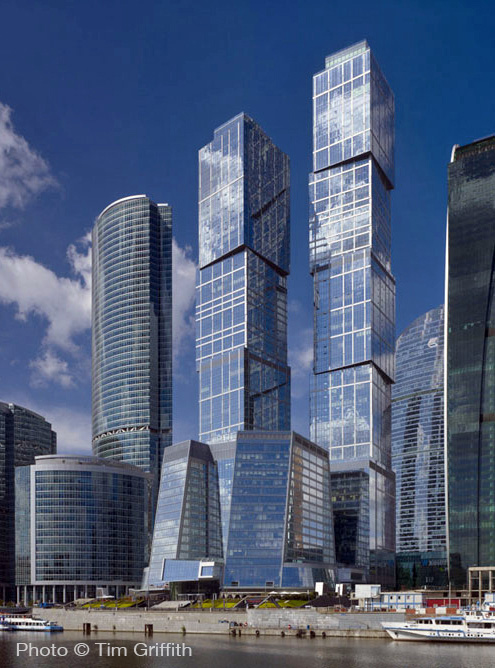
Empire formerly the Imperia Tower, is a complex in the Moscow International Business Center, a 60-story, 239 metres (784 ft) and a 14-story building with a height of 53 metres (174 ft) that is currently under construction. Construction of the skyscraper started from 2001 to 2002, but halted in 2003 until it was resumed in 2006 and was completed in 2011. The 14-story building started construction in 2013 and is planned to be finished by 2018.
Eurasia (Steel Peak) is a 308.9 meters (1,013 ft) tall skyscraper in located in Moscow International Business Center with offices, apartments, a hotel, fitness center, and a casino. It is also the fifth-tallest building in Russia, (2006-2014)

Evolution Tower is a skyscraper located in Moscow International Business Center and is 55-story office building, 255 metres (837 ft). Noted for its futuristic DNA-like shape (2011-2014). In 2016, Transneft bought the Evolution Tower for US$1 billion to establish its headquarters.

Federation Tower is a complex of two skyscrapers built in Moscow International Business Center named Tower East or Vostok and Tower West or Zapad. The supertall skyscraper Tower East (Vostok) is currently the second tallest skyscraper in Europe 2005- 2008 – 242 meters (794 feet). Vostok was completed 2017 with a height of 373,7 meters (1,226 feet), the tallest skyscraper of Russia and Europe. An observation deck was never completed and was dismantled afterward.
Mercury City Tower in the Moscow International Business Center – 338.8 m (1,112 ft)
butyrskii__igor.jpg)
Naberezhnaya Tower is an office complex composed of two skyscrapers and a high-rise in the Moscow International Business Center (MIBC) named from the lowest to the tallest: the 17-story tall Tower A, the 27-story tall Tower B, and the 59-story, 268.4 metres (881 ft) tall Tower C (2003-2007).

OKO is a complex of two skyscrapers in the MIBC – mixed-use complex houses apartments, office space, a 5-star hotel. North Tower or OKO Office Tower is 354.1 m (1,162 ft) and 49-story; South Tower or OKO Apartment Tower is 245 m (804 ft) and 85-stories. The complex also has a 12 story car park.
Narkomfin Building is a block of flats at 25, Novinsky Boulevard, in the Central district of Moscow, Russia. It is a renowned example of Constructivist architecture and avant-garde interior planning. Though a listed “Cultural Heritage Monument” on the Russian cultural heritage register, it is in a deteriorating state. Most units were vacated by residents years ago.
.jpg)
Main building of Moscow State University
Mosfilm Tower on Mosfilmovskaya street, is a residential complex consisting of 2 towers: one of 213 meters (54 floors) and the other 131 meters and 34 floors. The building was completed in December 2011.
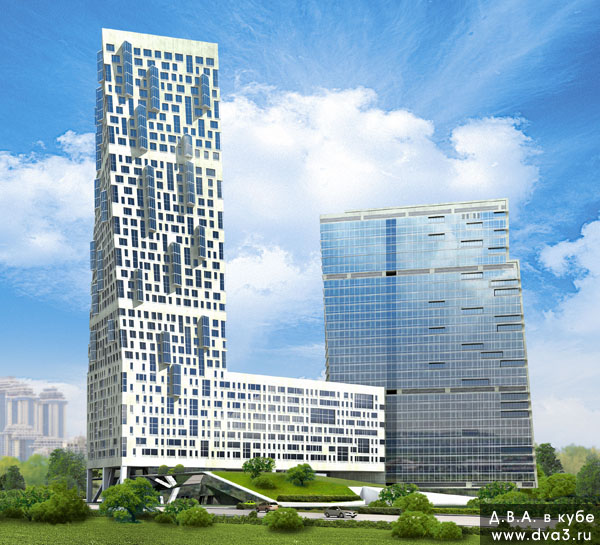
Mosselprom building is a monument to Russian constructivism and avantgarde architecture in the centre of Moscow on an intersection between Kalashny, Nizhny Kislovksy and Maly Kislovky side streets. It is notable for its painted panels. The building was originally intended as a seven-story apartment house with restaurant, built in 1912-13 by Strukov; however, it was hastily constructed and collapsed on March 22, 1913. A part of the structure was rebuilt by 1917; in 1923-1925 two more floors were added for storage and offices for Mosselprom, the Moscow Rural Cooperative Administration that combined flour, confectionery, and chocolate factories, breweries, and tobacco companies. In the 1930s it reverted to an apartment building and it currently houses a branch of the Russian Academy of Theatre Arts.
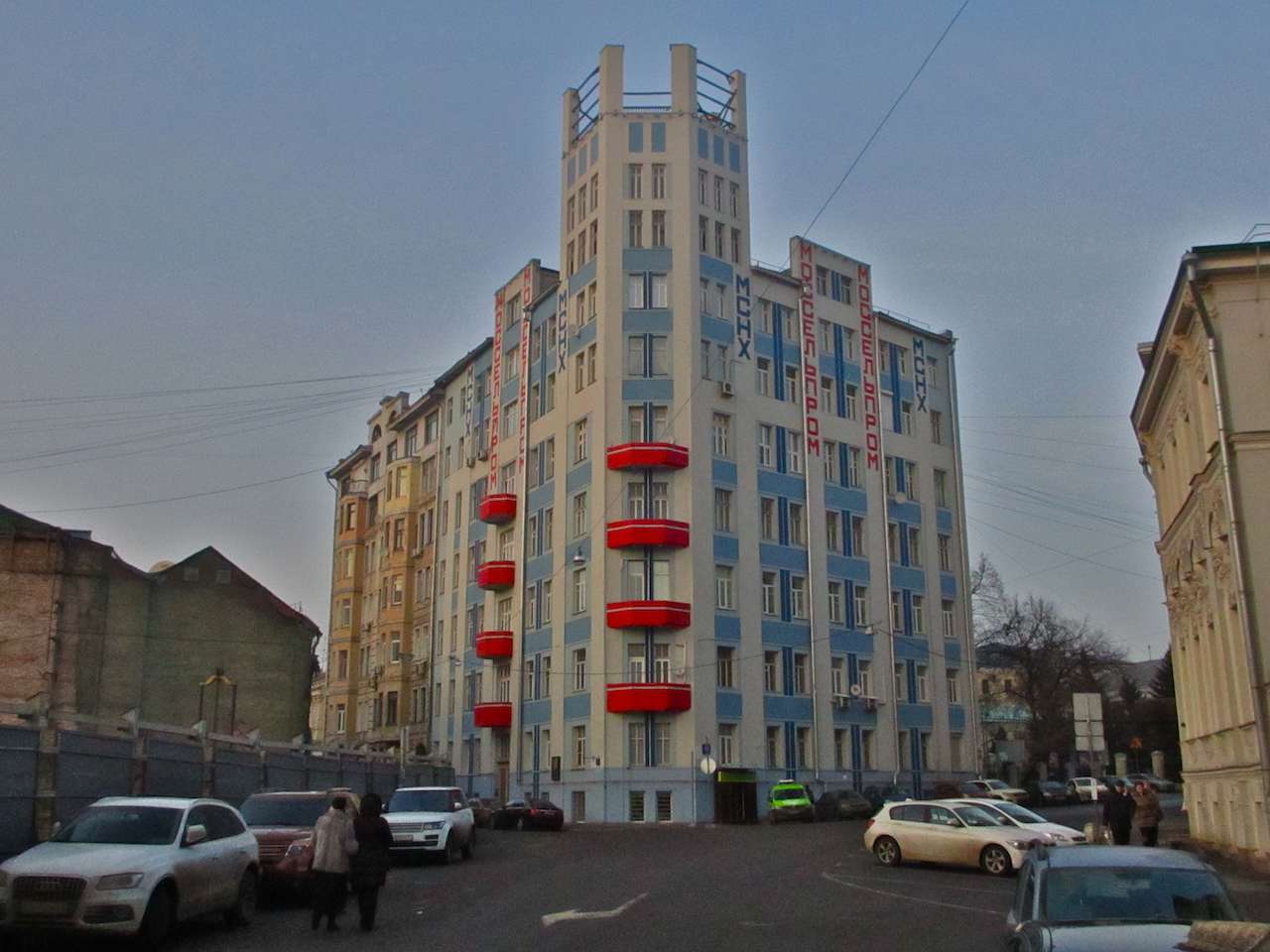
Ostankino Tower is a television and radio tower owned by the Russian TV and Radio Broadcasting Network. Standing 540.1 metres (1,772 ft), it is the tallest free-standing structure in Europe and 11th tallest in the world. Between 1967 and 1976 it was the tallest in the world. The tower was the first free-standing structure to exceed 500 m (1,600 ft) in height. Ostankino was built to mark the 50th anniversary of the October Revolution. It is named after the surrounding Ostankino district of Moscow.
Construction 1963-1967 use of prestressed concrete resulted in a simple and sturdy structure. It surpassed the Empire State Building to become the tallest free-standing structure in the world. It held this record for eight years until it was overtaken by the CN Tower in 1975, which surpassed its height by 13 metres (43 ft). The Ostankino Tower remained the second-tallest free-standing structure in the world for another 32 years until the Burj Khalifa surpassed both it and the CN Tower in height in 2007.
Radisson Royal Hotel
Rusakov Workers’ Club
Seven Sisters are a group of seven skyscrapers in Moscow designed in the Stalinist style. They were built from 1947 to 1953, in an elaborate combination of Russian Baroque and Gothic styles. The seven are: Hotel Ukraina, Kotelnicheskaya Embankment Apartments, the Kudrinskaya Square Building, the Hilton Moscow Leningradskaya Hotel, the Ministry of Foreign Affairs main building, the main building of the Moscow State University, and the Red Gates Administrative Building.
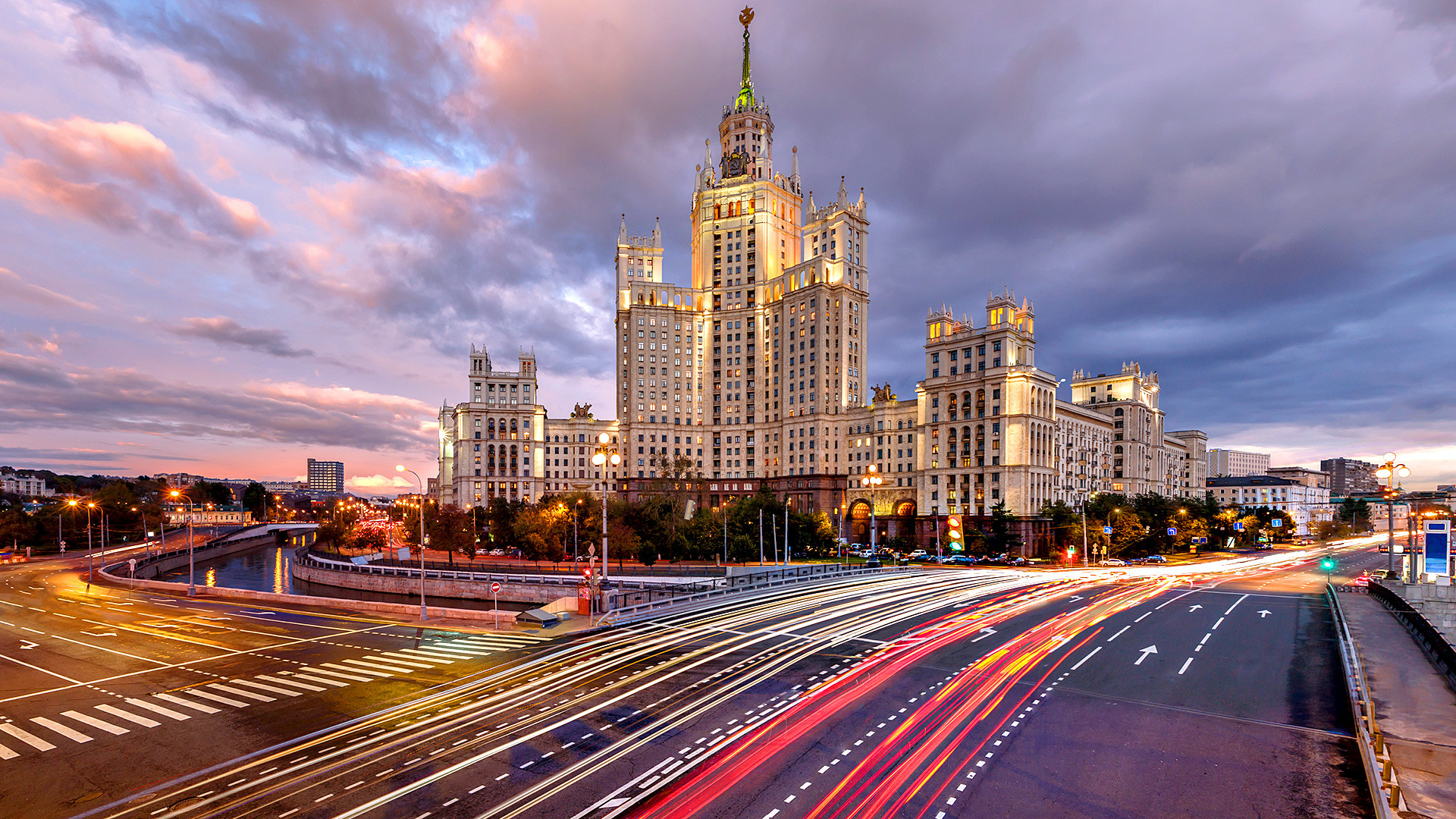
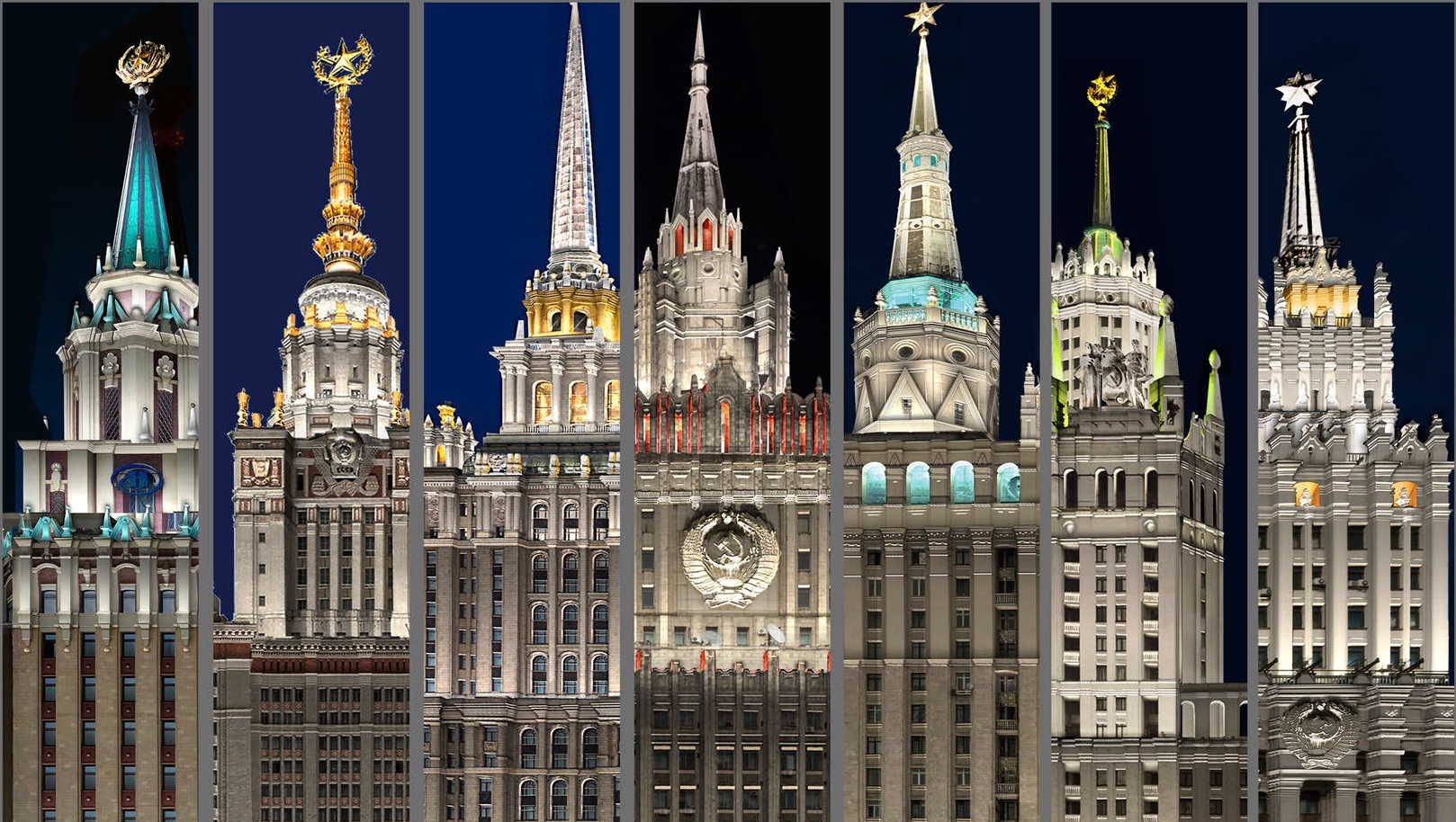
Triumph Palace is the tallest apartment building in Moscow and all of Europe. It is sometimes called the Eighth Sister because it is similar in appearance to the Seven Sisters skyscrapers built in Moscow under Joseph Stalin through the 1950s. Construction began in 2001-03). The 57-storey building, containing about 1,000 luxury apartments, 264.1 metres (866 ft).
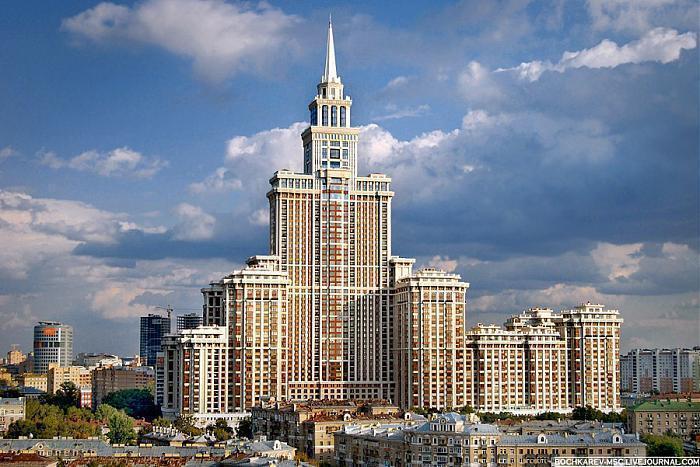
Tsentrosoyuz Building (Centrosoyuz Building) on 39 Myasnitskaya Street is a government structure (1933) by Le Corbusier and Nikolai Kolli. It included office space for 3,500 personnel, as well as a restaurant, lecture halls, a theater, and other facilities. Currently it is the home of Rosstat, the Russian Federal State Statistics Service and Federal Financial Monitoring Service (Russian financial intelligence unit).
 Zuyev Workers’ Club (1927-29). The building was designed to house various facilities for Moscow workers, and utilises an innovative glazing treatment at its corner which has proved very photogenic. The building facade consists of cylindrical glazed staircases intersecting with stacked rectangular floor planes to create a dramatic composition. A sequence of club rooms and open foyers lead to an 850-seat auditorium.
Zuyev Workers’ Club (1927-29). The building was designed to house various facilities for Moscow workers, and utilises an innovative glazing treatment at its corner which has proved very photogenic. The building facade consists of cylindrical glazed staircases intersecting with stacked rectangular floor planes to create a dramatic composition. A sequence of club rooms and open foyers lead to an 850-seat auditorium.
Access to the Izmailovo Kremlin and Market is easy, with Partizanskaya metro station a 10-minute walk away.
OTHER TOURIST SIGHTS IN MOSCOW
Museums:
Bulgakov Museum
Central Armed Forces Museum
Eksperimentarium
Garage Museum of Contemporary Art
Jewish Museum and Tolerance Centre
Memorial Museum of Cosmonautics
Moscow Museum of Modern Art
Multimedia Art Museum
Museum of History of Moscow
Museum of Retro Cars
Museum of the Great Patriotic War
Pushkin Museum
State Darwin Museum
Vernadsky State Geological Museum
Castles, Palaces and Forts:
Grand Kremlin Palace
Kolomenskoye palace
Kuskovo Palace
Ostankino Palace
Palace of Facets
Terem Palace
Tsaritsyno palace
Gogol Center, Russia’s leading avant-garde theatre is a multi-use arts complex in Moscow, featuring movies, music concerts, a discussion club, and performances by Russian and foreign directors on several stages. The Center is noted for its stagings of contemporary Russian Dramas and a lobby featuring neon-lit mirrors shaped like famous directors. and as part of recent news related to Russian State censorship of the arts. The Center’s has recently hosted dance companies.
Moscow Zoo
Moscow Oceanarium
Moscow Planetarium
Moscow University Botanical Garden
Bloshiny Rynok “flea market”. Big market/exhibition every three months or so with top quality pre-revolutionary antiques, clothes and shoes.
Izmailovo Kremlin. In the northeast Izmailovo District near the Serebryano-Vinogradny Pond, this Kremlin is a fairytale-like cultural wonderland – a wooden complex completed in 2007, is a cultural centre and marketplace loosely modelled after traditional Russian architecture and fairytale depictions of Old Russia. Wander about and you will spot the Romanov emblem of a crowned griffin decorating everything from buildings to fences, as well as a pink statue of Lenin that has caused some mild outrage.
The colourful and bustling complex is home to several single-subject museums. One is dedicated to Russian folk art, another to bread, and yet another to vodka. It includes a wooden replica of the summer palace of Tsar Alexei Mikhailovich, where visitors can experience a traditional Russian meal. It is also home to the Church of St. Nicholas, named after the patron saint of crafts and trade, which at 151 feet in height is the tallest wooden church in the country.
Izmailovsky Market. Has favourite Russian souvenirs, a collection of vendors and shopping streets, punctuated with colourfully whimsical buildings that give the area an overall “gingerbread village charm”. The area is broken up into a few different sections. The most iconic is the Izmailovsky Kremlin.
Bogdan Khmelnitsky (Kievsky) Pedestrian Bridge, Instead of scrapping the old steel arch, city planners re-used it as a structural core of the new pedestrian bridge, half a mile upstream. Main pedestrian walkway and stairs are completely enclosed in a glass canopy; there are two open-air side walkways, which are usually closed to the public. Shoreside pillars and staircases of grey stone are a close but simplified copy of the original Krasnoluzhsky bridge approaches. The bridge was opened on 2 September 2001.

Aviapark (2014) is a six-story shopping centre in the Aeroport District of Moscow. It is the second largest shopping mall in Europe. 500 stores and a four-story aquarium that extends to the ceiling of the retail section (the tallest cylindrical aquarium in the world at 22.31 metres (73.2 ft). There is no direct access to the mall on the Moscow Metro.
GOLDEN RING
For 300 years, before Moscow was capital, several towns north of Moscow were the seats of power of medieval Russia.
To see Vladimir and Suzdal, I exchanged a night in my hostel for its counterpart hostel in Suzdal. Catch the train from Kursky vokzal train station, 3¼ hours to Vladimir (198kms from Moscow and the end of the line).
Vladimir. Established as the capital in 1157, it lasted for less than 100 years. Above the railway station are two nice churches, the Assumption Cathedral (built 1158, frescos) and the Cathedral of St Dmitry (built 1193-1197, amazing stone carvings on the outside). They are both World Heritage listed.
Suzdal. In 1864, the Trans-Siberian Railway bypassed Suzdal, 35km south of Vladimir, in favour of Vladimir, so Suzdal, was bypassed not only by trains, but by the 20th century.
Full of cute wooden cottages, it was transformed into a major monastic centre in the times of Ivan the Terrible. The walled Intercession Convent (1364) was a place of exile for the unwanted wives of tsars. The Saviour Monastery of St Euthymius was founded in the 14th century. Its enormous walls protected the town’s northern entrance. An all-inclusive fee of 350R gets you into several attractions including a church, bell tower, prison and exhibits. The Kremlin with its 1.4km-long rampart contains houses and the usual spate of churches. Suzdal is a lovely place to stroll around with its meandering river.
In retrospect, it is toss-up whether to see these Golden Ring towns or stay in Moscow. I think I would have stayed in Moscow. Most of the sites were churches, but the scenery and location of Suzdal were very nice.
Gorokhovets (pop 13,500) is a city of Vladimir oblast, sacked by the Mongols in 1239, enjoyed a golden age in the 17th century, a centre of commerce for a large area, including Vladimir. Churches, monasteries and belfries were built. In the 1600s, the Monastery of St. Nicholas, Monastery of Candlemas, Annunciation Cathedral, Church of the Resurrection were built due to the advantageous situation of the city on the route between Moscow and Nizhni Novgorod. Large and spacious stone buildings began to be built by the richest and most notable. The two parts of the traditionally formed city: the oldest is located on the Mount of St. Nicholas, and the most later (the town) lying at the bottom of the river. The public square was the centre of all administrative institutions not the Kremlin. Planning took into account the natural terrain with high undulating plains and flood plains of the river created a very picturesque scene, rare for other Russian cities. In the appearance of Gorokhovets, in his artistic laws, there was nothing accidental. Everything was built on calculation, knowledge, laws, practices. Stone for the construction of cathedrals and churches replaced wooden cathedrals and white stone merchant’s buildings. Comfortably seated around them was a series of wooden buildings covered with elaborate carpentry decorations made by carpenters, further emphasizing the whiteness of the facades of the stone buildings.
On September 21, I boarded the Trans Siberian train for the three-day trip to Irkutsk and Lake Baikal, half way to the Pacific. The train leaves from Yarslavky Station (connected to Komsomolskaya Metro, the same as for trains between Moscow and St Petersburg), at platform 4 on the far eastern side of the metro/train complex (directions are great until you exit the train statin, then they disappear). The train departed exactly on time.
Some Personal Observations on Russia and Russians
St Petersburg and Moscow have the appearance in their central areas of being very affluent. The number of expensive German cars, luxury Japanese models and Cadillac’s is unbelievable. The only stores you see are high-end brand-name ones. The buildings rival those of Paris or Buenos Aires. There is no litter, no recycling and no homelessness. The restaurants and bars are full. I can only believe that it is different elsewhere in the country.
The women in St Petersburg and Moscow seem to be an unusually attractive bunch. I doubt if they are the most beautiful in the world and I am sure you would get arguments from Venezuelans, Poles or many other countries. When contemplating what adds to the allure of Russian women, some of the factors I came up with are: they are very slim, unusually tall (hard to tell with the heels), lots of makeup, expensive hair-styles, expensive clothes (short black leather jackets are in vogue), and spike heels. Russia is an example, like many other countries, where women have an ‘ornamental’ function in society. Probably most women would look this good with all this money spent on appearance. There must be a great deal of pressure – personal and from the men – to be so slim. And the spike heels are so impractical. However Russian women don’t seem to age well with obesity common in virtually all over the mid-forties. The eastern European bride market is big, but they and especially these Russian women would be too expensive for me. Outside of those two large metropolitan cities, it appears that most of the ‘beautiful people” have left.
Men, on the other hand do not measure up. Often overweight with Putin style buzz cuts, mediocre dress and a red-faced ‘swarthiness’ from too much vodka. On my exploration of Moscow’s metro system on a Saturday night, there was sporadic drunken behaviour and a huge police presence. Drinking is an obligatory part of Russian social behaviour and contributes to the markedly decreased longevity of both men and women. Few wear hats or sunglasses. Neither facial hair nor long hair are common.
You don’t see many old people. Maybe they aren’t where I was, but more likely, they don’t exist. The only panhandlers I saw were elderly women. With the recent issues in Ukraine and resulting sanctions, government budgets were rearranged and money supposed to go into the national pension scheme didn’t. This doesn’t bode well for the country’s elderly. I stand out – long hair, hat and flip-flops (I am the only person wearing flip-flops in Russia and get many stares and shakes of the head).
Many stores, especially the brand stores have their name in Latin letters. It just seems odd with the level of English so poor. Recently I was in a food court in Irkutsk and the only store name in Cyrillic was Baskin Robbins.
Russians are great readers and one sees many more reading on the metro than are on screens, which are uncommon.
The Vodka Wars. By far the greatest split between Vladimir Putin and Dmitry Medvedev came over vodka. Putin had occasionally spoken out against Russia’s national shame, but words were rarely matched by deeds that would threaten the state’s alcohol revenues. President Medvedev took a decidedly more aggressive approach to Russia’s vodka problem beginning in the summer of 2009. By the time Medvedev handed the presidency back to Putin in 2012, his anti-alcohol campaign had quietly produced marked improvements in Russian health. Consumption of all types of alcohol had dropped from 18 litres per capita to 15. Suicides, homicides, and – most telling – alcohol-poisoning deaths occurred less frequently. In 2011, “only” 11,700 Russians died from alcohol poisoning, quite a drop from the average of 36,000 a year during Putin’s first eight years (2000-08) but still some 50 times higher than the rate in Europe and North America. The same year, combined life expectancy for men and women surpassed 70 years (64.3 for men, 76.1 for women) for the first time since 1986, during Mikhail Gorbachev’s anti-alcohol campaign.


